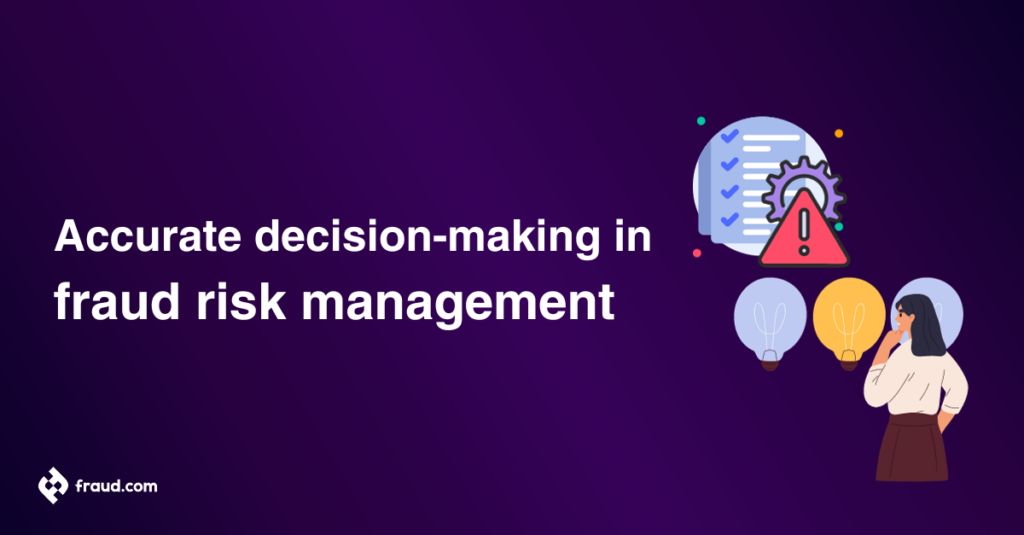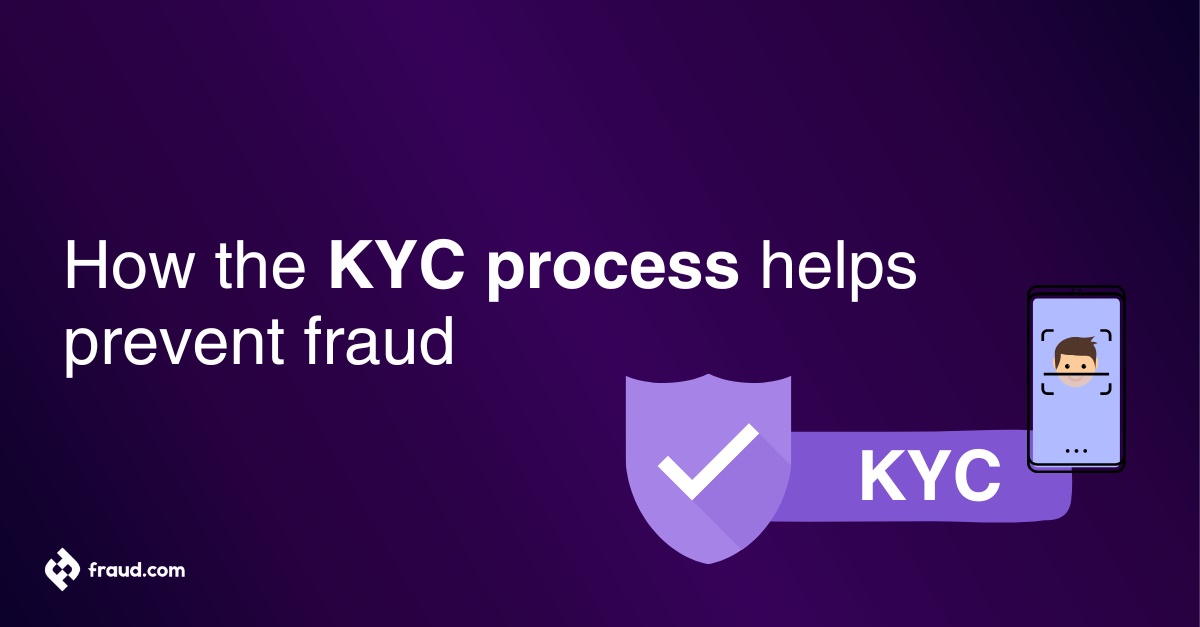In today’s increasingly digital world, the fraud risk management landscape has undergone significant transformation. Both organizations and individuals constantly face the looming threat of fraud, underscoring the need for a proactive and adaptable approach to prevent fraud, enhancing the customer experience and improving fraud risk management overall. At the heart of this approach is the skill of precise decision-making, which is crucial in the continuous fight against fraud and the improvement of prevention measures.
In this article, we delve into the vital aspects of making precise and timely decisions in fraud risk management and the strategies and technologies that empower this approach. So, join us in this exploration, where we aim to not only understand the dynamics of making precise decisions in the realm of fraud risk management but also harness the strategies and technologies that empower this approach to fraud risk management, ensuring a safer and more seamless digital world for all.
Table of Contents
ToggleThe significance of accurate decision-making in fraud risk management
The consequences of fraud, in terms of potential financial loss and damage to reputation, are far-reaching. Accurate decision-making is the key to minimizing these consequences, as it entails swiftly and effectively distinguishing legitimate transactions from potential fraud. Here’s why it’s indispensable:
- Minimizing financial loss through proactive fraud prevention: Fraudulent activities have the potential to inflict significant financial harm. The power of accurate decision-making lies in its ability to preclude these losses by swiftly identifying and preventing suspicious transactions before they materialize, acting as a financial guardian for your organization.
- Safeguarding reputation and elevating customer experience: Fraud incidents can cast a long-lasting stain on an organization’s reputation, affecting customer trust and increasing customer friction. In this context, the precision of decision-making becomes a guardian of not just financial assets, but also the trust and positive experiences that underpin the relationships with your valued customers.
- Striking the balance between fraud prevention and customer experience: Achieving the right balance between robust fraud prevention and a seamless customer experience is key to achieving an effective fraud risk management approach. Accurate decision-making is significant in this balancing act, ensuring that anti fraud measures don’t compromise the user journey, creating a win-win scenario for both security and customer satisfaction.
- Meeting regulatory compliance standards: In today’s highly regulated landscape, many industries are obligated to comply with strict regulatory and compliance standards. Robust fraud prevention systems are a non-negotiable requirement, and accurate fraud reporting and compliance for decision-making stand at the heart of meeting these obligations, guaranteeing adherence to the law.
- Enhancing operational efficiency through effective fraud management: The repercussions of fraud reach beyond financial loss; they often trigger a cascade of operational disruptions and administrative overhead. The efficiency of identifying and addressing fraud in a timely and precise manner acts as a shield against these unwanted side effects, ensuring the smooth operation of your organization.
Strategies and technology for efficient decision-making
Accurate and efficient decision-making in fraud prevention is a multifaceted challenge that requires a harmonious integration of strategies, technologies, and best practices. Technology, in particular, plays a pivotal role in empowering organizations to make precise decisions in the ever-evolving landscape of fraud. Let’s delve into various technological tools and solution strategies that can significantly contribute to this endeavour:
- Data analytics and Machine Learning (ML): In the age of big data, harnessing the power of fraud data analytics and machine learning is paramount. These cutting-edge technologies allow organizations to delve deep into their data, identify hidden patterns, and promptly detect anomalies that may signify fraudulent activities. Advanced ML algorithms excel at real-time monitoring, quickly flagging deviations in transaction behavior, and thereby enabling swift and informed decision-making.
- Predictive analytics for fraud prevention: Behavioral analysis lies at the core of predictive analytics in the realm of fraud prevention. It hinges on the understanding of user behaviour to establish a baseline and detect deviations. This in-depth scrutiny of typical user patterns empowers organizations to rapidly identify potential fraud, thereby elevating the accuracy of decision-making. Moreover, predictive analytics allows for the creation of profiles that can predict potential threats based on user activity, further fortifying the fraud prevention strategy.
- Real-time fraud detection: The adoption of real-time fraud prevention monitoring systems is pivotal for decision-making in fraud prevention. These systems continuously assess transactions as they occur, granting organizations the ability to make instant decisions and execute timely responses. This real-time approach is an effective means of preventing fraudulent activities before they escalate.
- Multi-Factor Authentication (MFA): To bolster security, organizations should mandate multi-factor authentication for sensitive transactions. MFA introduces an additional layer of protection, making it significantly more challenging for fraudsters to gain unauthorized access. Consequently, decision-making becomes more secure and robust.
- Rule-based systems for fraud prevention: Employing rule-based systems allows organizations to define specific criteria for identifying fraud. When transactions meet predefined fraud indicators, these rules can trigger alerts or actions, facilitating quicker and more precise decision-making. Such systems are adaptable and customizable to suit the unique needs of an organization.
- Training and awareness for fraud prevention: Decision-making in fraud prevention is not solely dependent on technology. It also requires an informed and vigilant workforce such as fraud investigators. Investing in training programs and awareness initiatives can educate employees and users about the latest fraud tactics, fostering a culture of vigilance that complements technological solutions.
- Incident response plan: Preparation is key in fraud prevention. A well-defined incident response plan outlines how an organization should react when fraud is detected. This plan ensures a swift and coordinated response, minimizing the impact of fraudulent activities and improving overall decision-making during critical moments.
- Collaboration and information sharing for fraud prevention: In a rapidly evolving landscape, collaboration is essential. Organizations should actively participate in industry networks and information-sharing organizations that provide insights and intelligence on emerging fraud threats. Collaborative efforts enhance decision-making by tapping into a collective pool of knowledge, ultimately leading to faster and more effective responses to new tactics.
- Fraud detection software: Investing in advanced fraud detection software equipped with machine learning algorithms is a wise decision. These systems operate in real-time, identifying patterns and anomalies indicative of fraud with remarkable accuracy, thus enabling immediate and well-informed decision-making.
- Artificial Intelligence (AI): Artificial intelligence is a potent asset in the fight against fraud. AI can significantly enhance decision-making by learning from past incidents and rapidly adapting to new fraud tactics, making it a dynamic and proactive tool in fraud prevention.
- Biometric authentication: The use of biometric authentication methods, such as fingerprint or facial recognition, provides an extra layer of security and ensures more precise identity verification, contributing to the accuracy of decision-making in sensitive transactions.
- Big data analytics for fraud prevention: Leveraging big data analytics to process vast amounts of transaction data is instrumental in the fight against fraud. This data-driven approach allows organizations to swiftly identify fraudulent patterns and trends, constantly improving fraud management solutions over time, and thus enhancing decision-making capabilities.
In conclusion, achieving accurate and efficient decision-making in fraud prevention is an ongoing journey that necessitates the seamless integration of technology, human awareness, and strategic planning. The adoption of these technological tools and solutions, combined with proactive strategies and a well-informed workforce, forms a robust defence against the ever-evolving tactics of fraudsters.
Robust fraud prevention with accurate decision-making
Robust fraud prevention with accurate decision-making is essential for minimizing fraud losses, both internal and external, while also enhancing fraud risk assessments and employing certified fraud examiners.
Successfully fighting fraud requires a thorough and multi-faceted plan that surpasses traditional methods. In the constantly changing world of financial crime, where the risks are significant and the opponents are unyielding, companies need to embrace a comprehensive strategy for identifying fraud and controlling risk. This strategy includes utilizing advanced technology, applying top-notch practices, and cultivating a culture of fraud consciousness.
At the heart of this complex strategy lies the need for precise decision-making, a crucial pivot point fueled by insights derived from data and technological advancements like machine learning. Financial entities and organizations of all scales need to prioritize and allocate resources towards fraud prevention and risk management through accurate and effective decision-making, as it forms the bedrock of protecting their clients, maintaining their reputation, and securing their financial stability.
To elucidate, let’s delve into the core elements of this robust fraud prevention framework:
- Cutting-edge technology for detecting fraud: The dynamic nature of fraud necessitates advanced technological solutions that can swiftly detect fraud with precision. Machine learning, coupled with big data analysis, empowers organizations to stay ahead of fraudulent activities by identifying emerging patterns and anomalies in real-time. This technological synergy acts as an early warning system, enabling organizations to respond proactively and decisively.
- Precision to minimize false positives: While detecting fraud is paramount, organizations must also be vigilant in minimizing false positives, which can impede operations and erode customer trust. Accurate decision-making systems leverage sophisticated algorithms that not only pinpoint suspicious activities but also differentiate between genuine and false alarms, ensuring that legitimate transactions proceed unimpeded.
- Combatting payment fraud: Payment fraud represents a significant threat in today’s interconnected world, and its impact can be catastrophic. Accurate decision-making is instrumental in rapidly identifying fraudulent transactions, protecting both businesses and their clientele from financial losses. In this battle, machine learning models scrutinize transaction behaviour, enabling immediate action to thwart payment fraud attempts.
- Holistic risk management: Beyond the immediacy of detecting fraud and payment fraud, accurate decision-making plays a pivotal role in risk management and fraud risk assessments. By assessing a multitude of factors and historical data, organizations can gauge and mitigate risks effectively. This comprehensive risk management approach not only protects against immediate threats but also fortifies an organization’s long-term resilience.
- Fostering fraud awareness: Accurate decision-making in fraud prevention goes hand in hand with fraud awareness. Organizations must cultivate a culture where employees and customers are attuned to the ever-evolving strategies employed by fraudsters. Awareness campaigns and training programs equip stakeholders with the knowledge and vigilance required to spot and report potential threats.
In summary, in the battle against fraud and minimizing fraud losses, organizations must adopt a holistic approach that prioritizes the twin objectives of preventing fraud and managing risk. Cutting-edge technology, driven by machine learning and data analysis, forms the core of this strategy, ensuring that decision-making is not only accurate but also responsive and adaptive. By bolstering their defences, organizations can protect their customers, safeguard their reputation, and strengthen their bottom line in the face of evolving and relentless fraudsters.
While detecting fraud is paramount, organizations must also be vigilant in minimizing false positives, which can impede operations and erode customer trust. Accurate decision-making systems leverage sophisticated algorithms that not only pinpoint suspicious activities but also differentiate between genuine and false alarms, ensuring that legitimate transactions can be authorised.
Effective fraud risk management by fraud.com
In today’s dynamic fraud prevention landscape, robust risk management requires proactive and innovative solutions to address evolving threats. At fraud.com, we offer a comprehensive fraud management solution hub designed to enhance your fraud detection, risk mitigation, and reputation protection.
- Udentify: Identity verification and authentication by Udentify integrates cutting-edge biometric authentication to ensure precise real-time identification of individuals, adding an extra layer of security to sensitive transactions.
- aiReflex: Advanced fraud detection by aiReflex powered by state-of-the-art machine learning and AI. aiReflex swiftly identifies suspicious transaction behaviour, predicting potential threats and facilitating more accurate decision-making.
- fcase: fcase fraud orchestration streamlines fraud management by seamlessly integrating tools and automating processes, ensuring a swift and decisive response to emerging threats.
In conclusion, fraud.com empowers your organization to make accurate decisions in the ever-evolving landscape of fraud prevention. We are your beacon of security, safeguarding customers, protecting your reputation, and securing your bottom line in the digital world.









